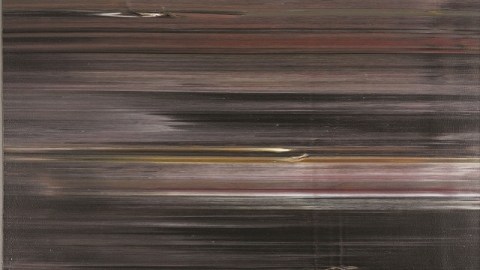Can the Visual Arts Have the Blues?

“Ain’t got no rest in my slumbers/ Ain’t got no feelings to bruise/ Ain’t got no telephone numbers/ I ain’t got nothing but the blues,” goes Jazz composer Duke Ellington’s 1945 song “Ain’t Got Nothing But the Blues.” Jazz wins credit as the only original American art form (and rightfully so), but before Jazz there was the Blues. The Blues began as an African-American phenomenon (and rightfully so, since for so long they had “nothing but”), but the idea of the Blues eventually spread to the human condition itself, adopted by every race and every means of expression, not just music. Blues for Smoke, which runs through April 28, 2013 at the Whitney Museum of American Art, illustrates how the visual arts got the Blues through the 90 works of painting, drawing, sculpture, photography, video, and installation art. As smoky and ill-defined as the idea of the Blues can be, Blues for Smoke pictures Blues as a fleeing feeling, a lasting philosophy, and nearly everything in between.
The exhibition takes its title from jazz pianist Jaki Byard’s 1960 solo album of the same name. Byard built a reputation as an elusive musician who could move easily from 1920s style stride piano to 1970s full-on funk and everything in between. By titling the exhibition Blues for Smoke, the curators embrace the elusiveness of their subject and turn an apparent weakness into a strength. “Blues for Smoke is an interdisciplinary exhibition that explores a wide range of contemporary art through the lens of the blues and blues aesthetics,” reads the press release for the show. “Turning to the blues not simply as a musical category but as a field of artistic sensibilities and cultural idioms, the exhibition features works by over forty artists from the 1950s to the present, as well as materials culled from music and popular entertainment.” Academic speak such as “interdisciplinary,” “aesthetics,” and “idioms” might have you heading for the door, but do not fear: the exhibition itself glories in the smoky pervasiveness and intangible emotion of the Blues itself.
The first work that greets you at the door is David Hammons’ 1989 multimedia installation titled Chasing the Blue Train. Riffing on the title of Jazz Saxophonist John Coltrane’s breakthrough album Blue Train, Hammons sets a blue toy train snaking around the lids of nine baby grand pianos arranged as a musical landscape. Hammons strikes an opening chord not just of fun and playfulness, but also of journeying and discovery. Coltrane appears several more times in the exhibition: realistically, wailing on his instrument in a 1961 photo by Roy DeCarava; and, later, abstractly, in William Thomas Williams’s 1969 painting titled simply Trane. As much as Blues for Smoke tries to go beyond music and musicians, the connection is inescapable. Beauford Delaney’s 1968 Portrait of Charlie Parker shows the iconic “Bird” with a little bird in the corner and fancifully dresses the subject in African-style clothing, almost like some kind of prophet. Struggling with mental illness, frail health, and alcoholism as well as an exile’s life in Paris, Delaney saw Parker, who also suffered from substance abuse and mental illness, as a patron saint of sorts whose music could serve as a guide and a warning.
Another photo by DeCarava from 1952 of a smiling, happy Billie Holiday, unfortunately, plays the wrong note. When I think of “Lady Day,” I see William P. Gottlieb’s 1947 photo of her mid-song, head tipped back, eyes closed. “I’ve been told that nobody sings the word ‘hunger’ like I do. Or the word ‘love,’” Holiday wrote in her autobiography, Lady Sings the Blues. “Maybe I remember what those words are all about.” DeCarava’s photo sings neither hunger, nor love—the two halves of the Blues. For a moment, at least, Blues for Smoke forgets what those words, and their exhibition, is all about.
Of all the homages to Blues or Jazz music in the show, the image that embodied the aims of the exhibition best, at least for me, was Jack Whitten’s 1974 painting Black Table Setting (Homage to Duke Ellington) (shown above). Just as Ellington resisted the labels of Blues and Jazz and called his music “beyond category,” Whitten’s painting resists the literalist labels of visual art and musical art and finds the hazy space between, the (possibly unattainable) place beyond category that Blues for Smoke strives for but doesn’t always reach. Whitten’s title Black Table Setting finds a photographic analog in the work of Carrie Mae Weems when it captures the down home feel of the Blues of family struggles and family joys. John and His Dogs/John the Rolling Stone, Alice on the Bed, Dad and Me, Mom at Work (a diptych), and Mom in the Kitchen. Weems, like Holiday, knows hunger and love well.
When the pieces in Blues for Smoke venture beyond musical inspiration, they often seem stretches. Perhaps the best non-musical Blues piece finds inspiration in the world of African-American comedy. Borrowing a joke from comedian Richard Pryor, conceptual artist Glenn Ligon painted a series of works titled No Room (Gold). “I was a n—-r for twenty-three years. I gave that sh-t up. No room for… No room for advancement,” Pryor joked (but with the obscenities intact). Lignon hand stenciled Pryor’s joke, including the verbal misstep in the middle, on a gold background, thus transforming Pryor’s comedy gold into Blues humor, a state of mind where, Ellington would agree, you “ain’t got nothing but the blues” and the freedom to laugh about it.
Blues for Smoke manages, at its best, to balance the sad hunger and the joyous love of the Blues. At its weakest, it denies the musical foundation that gives it form, becoming as ungraspable and intangible as the smoke in its title. Stan Douglas’ black and white video installation Hors-champs, in which a group of Jazz musicians play Albert Ayler’s “Spirits Rejoice” reminds us that the Blues rejoice as well as cry, but each mood expresses the same complexity of the human spirit. Byard, whose album inspired Blues for Smoke’s title, continued performing and recording until 1999, when a single, stray bullet killed him at the age of 76 in an incident that remains unsolved today. Small details such as that mystery—the stuff of the human comedy itself—make the Blues the Blues. That tautology might be no more helpful than an atmospheric analog, but Blues for Smoke takes a difficult concept and, more often than not, makes it sing.
[Image:Jack Whitten. Black Table Setting (Homage to Duke Ellington), 1974. Acrylic on canvas. 72 x 60 inches. Collection of the Art Fund, Inc. at the Birmingham Museum of Art; Purchase with funds provided by Jack Drake and Joel and Karen Piassick.]
[Many thanks to the Whitney Museum of American Art for the image above and other press materials related to the exhibition Blues for Smoke, which runs through April 28, 2013.]





